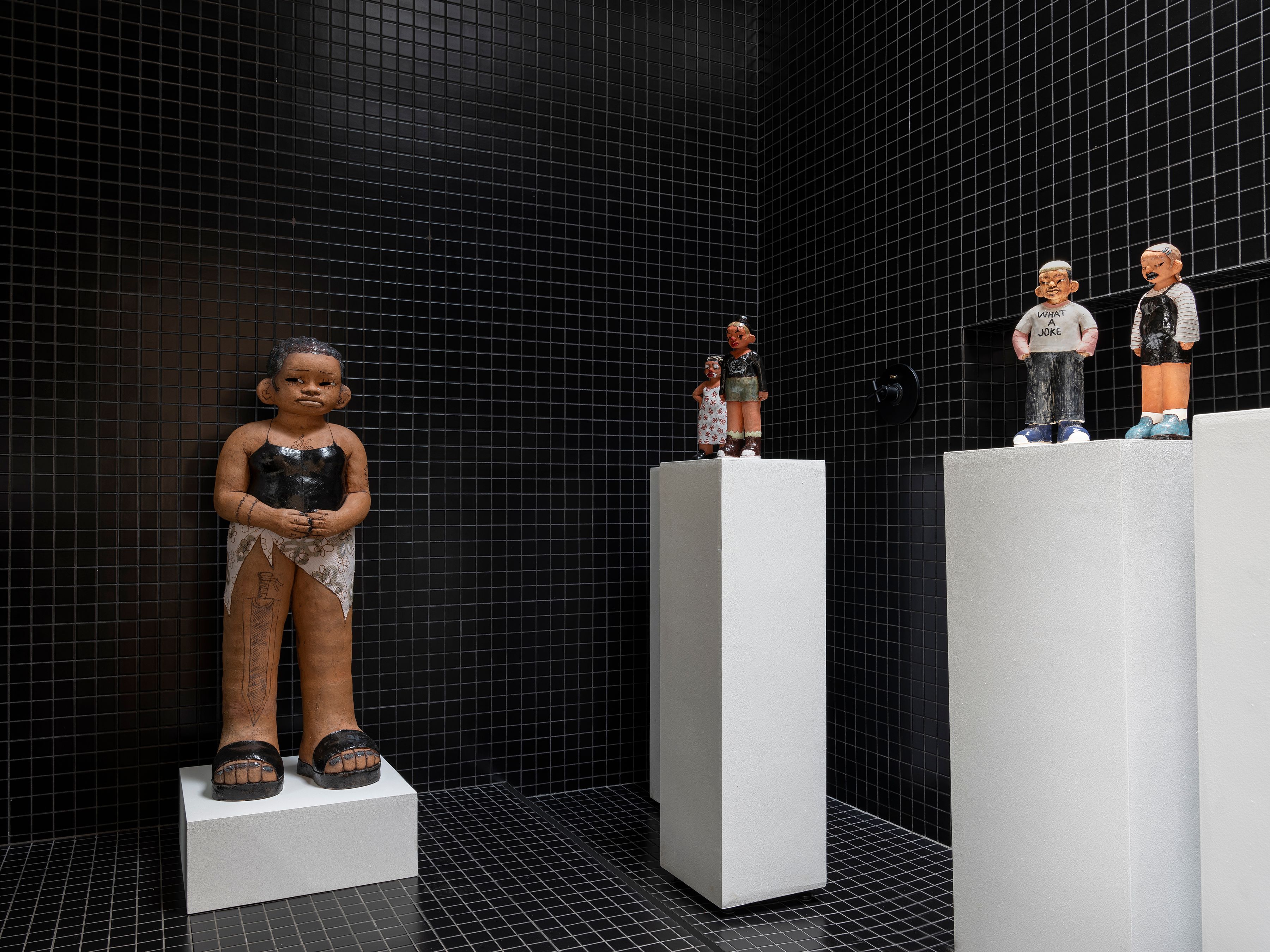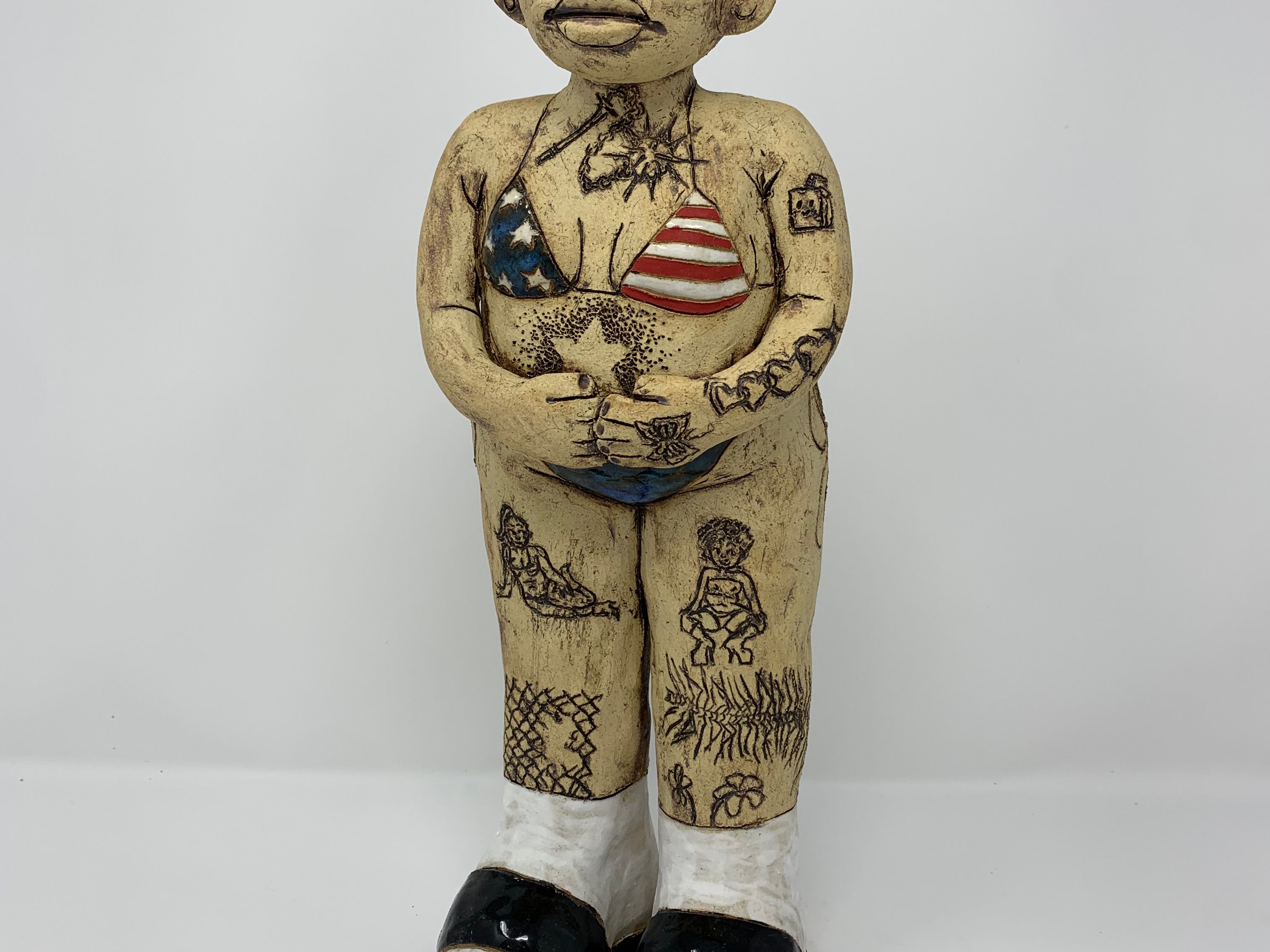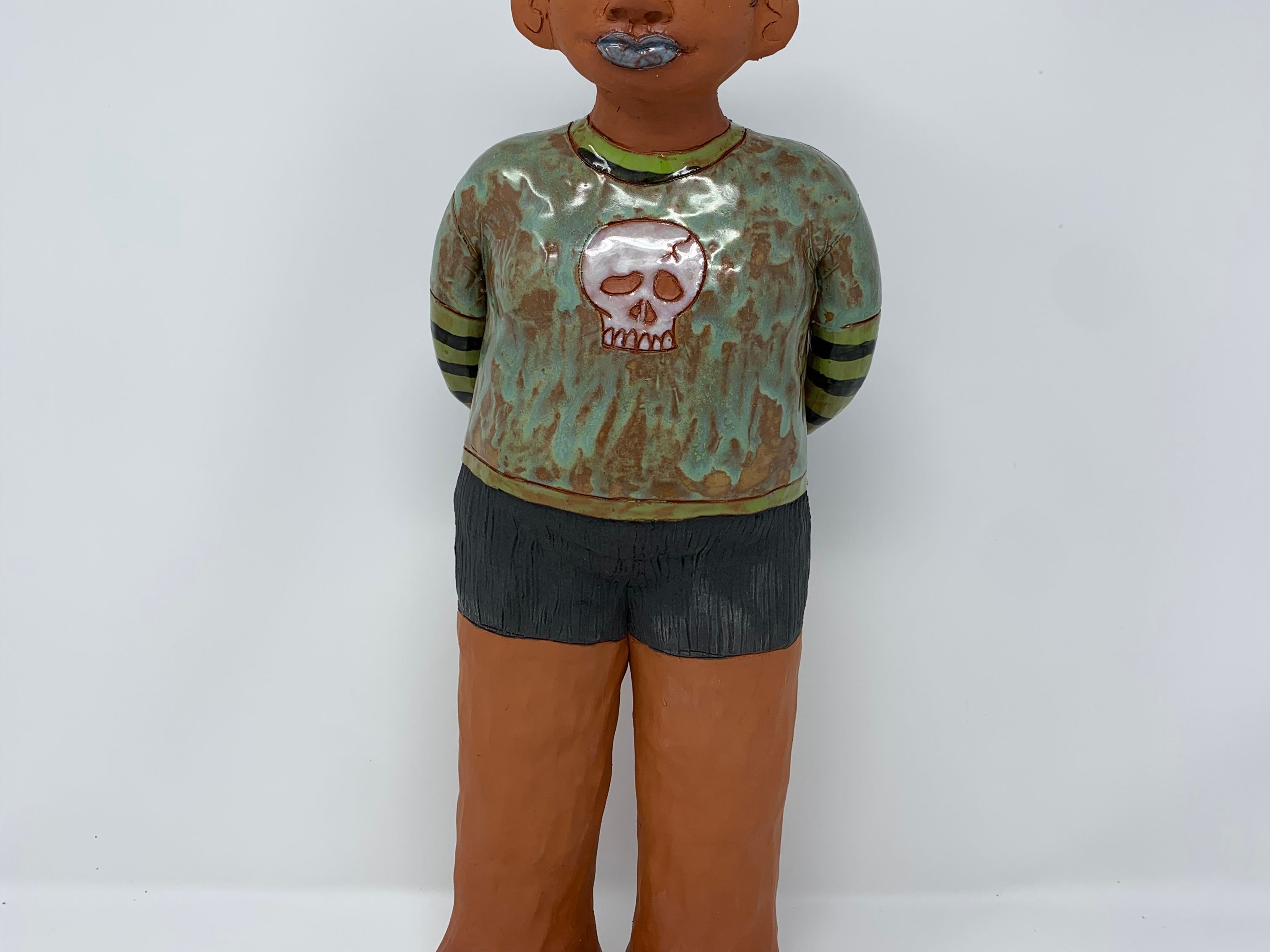
“I've learned this,” Sydnie Jimenez explains with a playfully conspiratorial air. We are speaking over a late October video call and my laptop camera is unable to connect – the lively mood she gives off is infectious, nonetheless. The blank, black square which would have shown my returning smile is no barrier. “People love a little face. And these figures have little faces. Because I do figurative work and I love to sculpt faces, it draws people in and really quickly. Then I'm like, okay, did I get you? Are we here together now?”
The Orlando, FL native and School of the Art Institute of Chicago graduate has drawn plenty of admirers to these characters of her making in the few years of her burgeoning career. Jimenez’s figurative ceramic sculptures draw from a lifelong appreciation of comics and animation, standing in complete command of a space whether 15 inches or four feet tall. Each figure a Black or brown youth occupying space their real life counterpart isn’t always welcome within. “If I make this, it's probably going to be in the world for a long time,” Jimenez muses. “Even if it’s broken, it will still be there.”
Her presentation for Untitled Art 2023 will display various clay bodies lending an organic array of visages in her preferred method of leaving the “skin” of each work unglazed, showing the raw material color. “With ceramic sculpture I've seen in America, at least, when people do figurative stuff, it's in porcelain or it's in a white stoneware. And cool, that's beautifully made, but I can't relate to it because I'm not white. I'm half white, but I don't present as a white person.”


Work like Jimenez’s provokes seamlessly. Her viewer is presented with something familiar as her sculptures scowl and smile, bear tattoos and piercings or are outfitted in ensembles that’d be just as much at home in a Heavn by Marc Jacobs campaign. Then, slowly, in witnessing the subjects of her making the story she’s woven behind each unfolds. Like she’s said: “Did I get you? Are we here together now?” Because a reckoning is coming.
Below, Jimenez speaks on the fluidity of her forms, unintentional influences, and the mystic blessing of “twin-ness.”
Arimeta Diop: I came across your work initially as a few of my friends, all of whom are trans and non-binary like me, were connecting with and reposting you. It created a meta commentary: this sense of community comes from the work itself – when all the figures are standing together, it feels like a crew within the space. Then there's also the surrounding community about you and the people who come together because of your work. How does that community aspect fold back into the process for you?
Sydnie Jimenez: I don't think of specific people when I'm making figures but definitely the people I choose to be around, my friends or who I work with or who I meet at parties, that's definitely all in here. It's in here with my other influences: animation and comics and Mesoamerican ceramics. It's all coming in and coming out into the figures. I can really appreciate hearing that about your friends and the trans community really connecting with my work because I have a big group of trans friends too. When I'm making something I don't specifically think “Oh, this is boy, this is girl.” It's a coil body; a little bit of boob sometimes. I think in that way, because it's so not specific – well, it's specific because they're thick; that's something of me, because I'm also a big gal, I want to make my work like that. But these hollow forms that are kind of lumpy because I like the pinched look of work, I think [people connect] really because it's not realistic body types. It could be easy to relate to that, I think.

AD: Maria from Mindy Solomon Gallery featured your gargoyle heads, Ancient Observer 3, and it felt like these are reimaginings of understood archetypes. I think that’s what you were just touching on, there are archetypes that are exoticized and othered by a white male gaze versus richer stories that could be told.
SJ: Those three figures I made for that show, the lifesize ones, are based off of the story of Mary, then one of Eve and then Lilith, who was the precursor to Eve in some Judeo Christian stories. I feel all three of these women… they're supposed to be perfect until they're not. Except Mary. She was so perfect, she ascended to heaven. But she was only seen as this viable womb, basically. And that was all the agency – at least the Christians who I've been around – give her. I grew up Catholic. Looking at women practitioners of Catholicism versus the men, I feel like some women think Mary's badass. The wrath of Mary? Crazy. You don't want to get on her bad side. And that's what I thought. If she's an angel now and she's the mother of God, I feel like she's gonna have some agency.
I'm also not a practicing Christian anymore because that's a crazy colonizer religion, but I still use this imagery in my work to talk about the stories within the religion. To say, hello colonization happened and this was imposed on people in South America, the Caribbean, North America, Africa, the whole world over because the West – England and Spain and Italy weaponized [religion]. They said, “We're the holy people,” and it was a justification for the horrors they committed. To make it okay to enslave Black and brown people, erase and kill people. So I also don't want people to forget that.
AD: You touched on this before, comic books, your people around you—what are your other wells of inspiration?
SJ: A big inspiration for me is my twin sister Haylie. And being a twin. I feel like people think a lot of my work is self portrait. I guess technically anyone's work could be a self portrait because they made it. With figurative artists, the face you see the most is your own: it’s that times 100 because of my twin sister. We grew up together, both went to the same art school. We work together, and we show together. So that's where the style of my work comes from, face-wise.


It’s really inspiring to have someone that close also wanting to take this scary leap of being an artist. I also think twins, twin-ness: people seem to be really mystified by it when twins are pretty common. But at the same time, I kind of get it. Identical twins shared the same egg, then they split. There's a good idea they could have had the same soul which split. I can believe that. I'm pretty sure that's true. So I totally get why there's sometimes spirituality around twins. Sometimes it's holy. It's inspiring to see her trajectory as an artist and her style change because we grew up the same way and have a lot of similar experiences. And we chose to go this route of figurative art and now she's using clay because I got her to join the dark side.
At the same time, I think our work is totally different. She is composing bodies in such a different way. Thinking in that way – by spatial layout – when she's making these scenes. And I'm like, this is a figure I'm looking at in the round and the context of the story is the clothing and the facial expression, and pose, and the sculpture next to it. I see our work as tangential and related but totally different. She is a tattoo artist and she gave me a bunch of tattoos. In quarantine, especially, I was the guinea pig. But tattoos are really special to both of us. So it's really fun when we get this chance for Haylie to tattoo my sculptures. I'm actually going to have some of these pieces at Untitled Art which is very exciting.

AD: Looking ahead, how do you see your practice evolving?
SJ: Right now, I'm doing another residency in Chicago. It's a year-long program at Lillstreet Art Center. Residences are really cool because you can work around other working artists. Then I also get the chance to teach at Low Street. After this, I'm excited to set up my own studio in Chicago, and I feel that way I can really focus – it's great working around other people, but sometimes it's distracting. At the same time, I'm gonna miss that.
At some point in the future, I'd like to do some metal work. I did some really small bronze casting pieces in school at SAIC, because we could. We didn't have majors so we could just take whatever classes. One of my big dreams in the future is to do public art and have these clay sculptures translate into monumental, steel and bronze sculptures. I've been making big work with clay and it's fun, but it's also fucking hard. With metal: I welded the piece together, now it's done!
AD: How do you grapple with the additional expectation that comes with holding multiple identities?
SJ: I feel the way a lot of artists work is just: what's around me, who's around me? And where am I? I'm gonna make work inspired by all this and travel to do that. I just feel like the difference is the context of my background but that makes it seem like it's just in the background, but it's actually something we live with, every day. Like microaggressions. I was living in Montana for two years. I was at a ceramic residency and the difference in my mental health and quality of life in that way, went way down. There weren't that many people. It was 98% white, and it was a small, small town kind of a city. And people there just didn't interact with Black and brown people a lot. We were pretty west there, so there's a liberal presence. People were like, yes women's rights, gay rights and Pride but then at the same time, what about race? Either people were hostile to me – when I first moved there, people left notes on my car, “go back to where you came from” – or, I'm at the bar, and guys would hit on me and my sister and say, “Oh, you're from Georgia, I have a lot of Black friends in Atlanta. I love Black people.”
I think it was worth it that I did the residency. But in my day-to-day life, I have to deal with this bullshit of not being a white person in a white supremacist society. And that's pain, that's anger and loss, and I feel that does go into my work. It's not just beauty, even though I want people to see beauty and joy in it.


AD: Despite that, do you think of your work as being in any kind of conversation with or in the lineage of a pre-colonial, non-Western history of sculpture?
SJ: I could visually see my work in that vein. It's so funny because when you go to a museum which is only where you can see pre-colonial work from non-Western peoples, it’ll say: “This [object] is for ritual purposes.” I feel like if people unearthed my work thousands of years later – ceramic is immortal – I think people could look at my work and impose spirituality on it. And I think that is something that could be common with pre-colonial works because of the context people put it in.
When you're a kid, you're making, you’re drawing; you're not looking at Renaissance paintings or Greco Roman sculptures. It’s just, what's here? I want to draw that. What's on the TV, look at these cartoons. I like that: I'm gonna draw something like it. And that's where my drawing style came from. Then I went to art school and was learning the history of all this. I get to museums and I see Mesoamerican, African art and I'm like, wait, this shit looks like animation, the proportions, it's not just photorealistic. In that way, too, I am influenced by pre-colonial work, intentionally, but I also think unintentionally.
Arimeta Diop is a journalist, writer, consultant and ceramicist whose words have appeared in Vogue, VICE and Politico. They are currently on staff at Vanity Fair where they focus on culture, art, books and fashion.